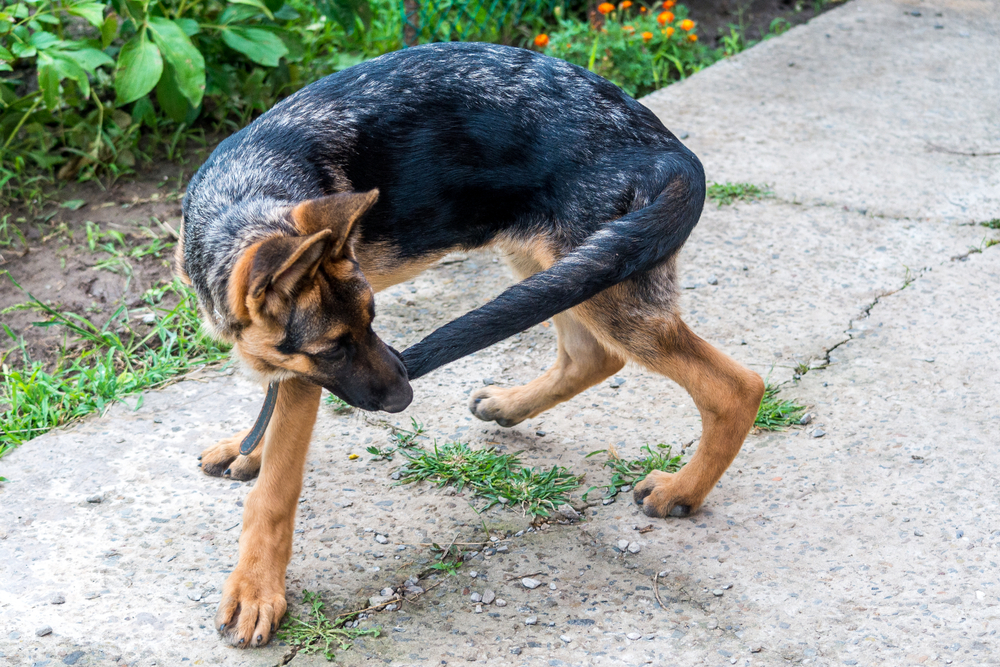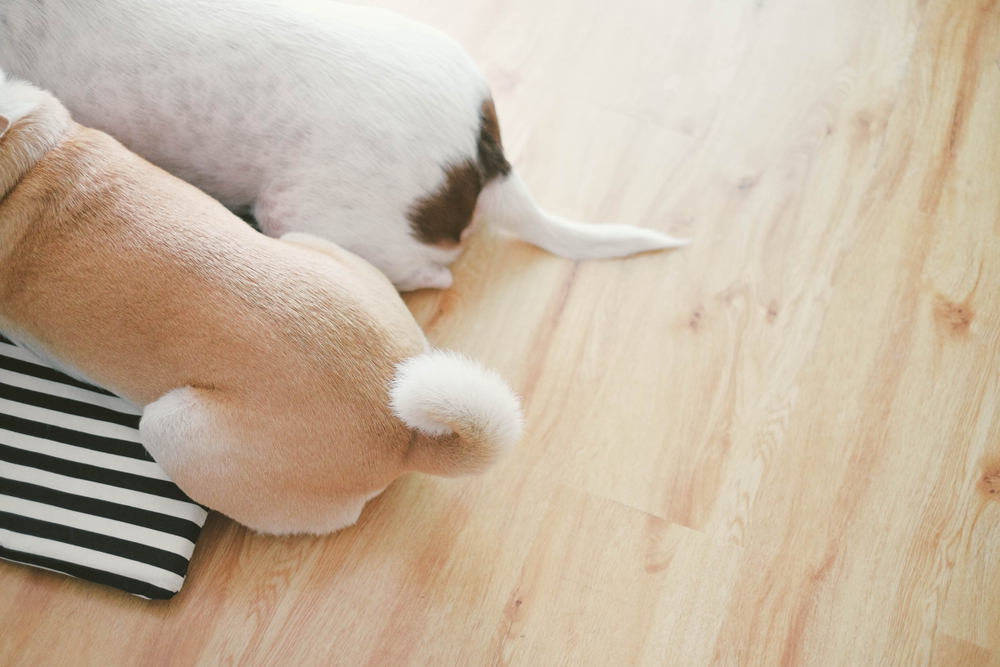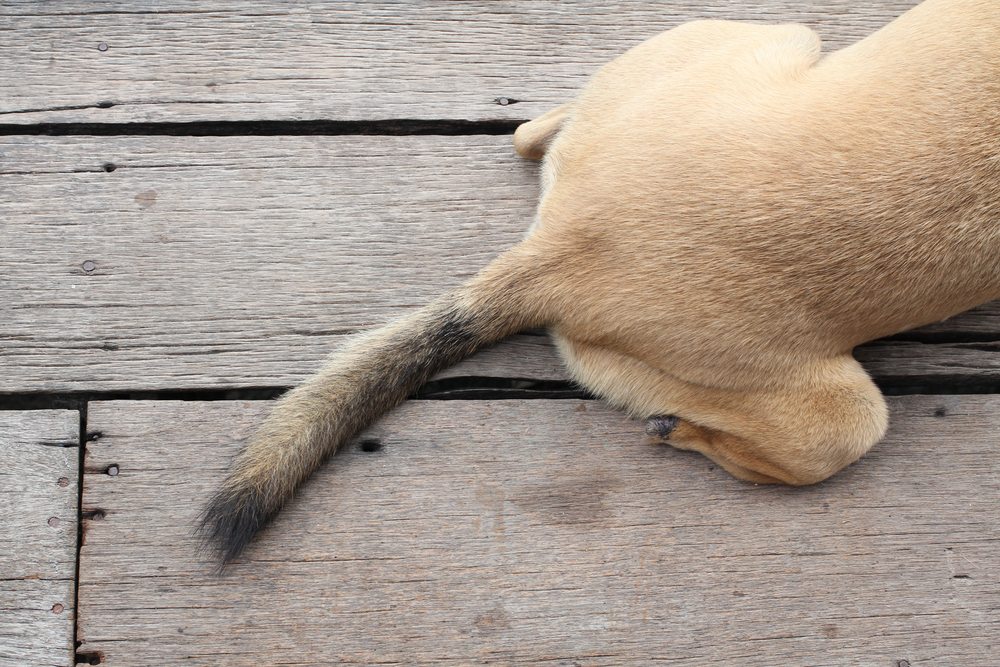
Caring for a dog requires patience, time, and effort–but it also takes money. Still, it’s worth it to see your dog happy and healthy. You’d do anything for them, so, it’s only natural to worry when you discover something unusual on your dog, like a bald patch.
What does it mean when your pup starts losing hair? How worried should you be if you find a bald spot on your dog’s tail? We’ll take a deep dive into what dog hair loss means, what you can do to treat it, and when you should see the vet for a bald patch in your pup’s fur.

Why is my dog losing hair? There are many causes of bald patches in fur
Depending on your dog’s breed, they may shed a little or a lot. However, if you’ve recently noticed your pooch shedding more than usual, it could be a sign that something is amiss. Here are some of the most common causes of hair loss in dogs.
Allergies are a common cause of bald patches on a dog’s tail
You’re not alone if you dread spring because of seasonal allergies, but did you know that your dog can also suffer from seasonal allergies? Like us, our four-legged friends can experience allergic reactions due to environmental factors (dust mites, pollen, and mold are common allergens), food ingredients, and even chemicals. If you’ve noticed dryness, redness, or hair loss after switching your pup to a scented shampoo, it’s probably a good sign that they’re allergic. Similarly, if your dog sneezes and experiences hair loss at certain times of the year, they most likely have seasonal allergies.
Infections can cause many symptoms, including loss of hair
Fungal, bacterial, and parasitic infections can all cause hair loss. Because some infections require specific treatments, it’s best to see your vet if you think your pooch may have an infection. In addition to hair loss, your pup may emit a strange odor, suffer from thickened skin, have pustules, or scratch incessantly.
Cushing’s disease is known for causing hair loss in dogs
If your pup is experiencing hair loss coupled with lethargy, increased urination, thirst, and appetite, they may have Cushing’s disease. Caused by an overproduction of cortisol by the adrenal glands, Cushing’s disease can become a life-threatening endocrine problem if left unchecked. You should take your dog to the vet as quickly as possible if you suspect they have Cushing’s disease. Some dog breeds are more likely to develop Cushing’s, so it’s good to read up on your pup’s breed to know what to expect.
Pressure sores can be uncomfortable and unsightly
Just like human senior citizens, older dogs tend to spend a lot of time lazing about in their favorite spot. While our senior buddies have totally earned the right to rest and relax, sometimes living a sedentary lifestyle leads to pressure sores. As the name would suggest, a pressure sore is caused by an uneven distribution of body weight (i.e. excess pressure) on certain spots on the body, causing hair loss and open wounds.
Insect bites can lead to itchiness, bald patches, and other reactions
Itching, swelling, rashes, and hives are common reactions to insect bites, but your pup may also experience hair loss. While some dogs are born with sensitivities to certain insects, others develop sensitivities later on in life. Whatever the case, you (and your pup) will feel much better after you consult your veterinarian. You can sometimes treat your dog’s reaction at home, but they may need additional treatment.
If you notice symptoms of facial swelling, severe itching, widespread redness, or breathing difficulty, take your dog to the vet immediately. Your pooch could be suffering from anaphylaxis, a potentially fatal allergic reaction that requires prompt veterinary care.
What does a bald patch mean?
Alopecia, the official term for partial or complete baldness in an area where hair growth is standard, typically occurs on a dog’s head, ears, stomach, and back. When bald spots are concentrated at your pup’s tail, though, it’s usually a sign that they’re suffering from an underlying health condition. For example, it could be a sign they have Cushing’s disease. But don’t panic just yet; there are a couple of other reasons your pooch might have a bald spot on their tail.
Behavioral issues can sometimes lead to hair loss
Does your dog suffer from anxiety? Whether your fur baby hides in the closet during thunderstorms or suffers from separation anxiety when you leave the house, bald patches on your dog’s tail don’t always mean they have a physical health problem. Dogs who suffer from anxiety and depression are inclined to compulsive behaviors, such as incessant barking or tail chewing. If your dog’s tail is constantly damp and disheveled, they’ve likely been chewing on it while you’re away.
Flea infestations often lead to bald spots on a dog
Is your otherwise calm dog suddenly biting at himself? Have you noticed tiny brown flecks in their coat? It sounds like fleas are the likely culprit. We recommend taking your pooch to the vet for a flea treatment, having pest control tackle your yard, and deep-cleaning your house to kill these tenacious pests.

How to soothe, heal, and prevent bald patches in your dog’s fur
Managing bald patches in fur might sound intimidating, but it can be pretty simple once you can find out what’s causing the hair loss. For example, a multi-step flea control process will get the job done for good if it’s fleas. If your dog is diagnosed with a medical issue, you and your vet will figure out the best plan of action for long-term relief. This may include topical shampoos or ointments, prescription medications, and keeping the area clean and dry.
Things might get more complicated if your veterinarian suspects an allergy, though. You may need to start your dog on an elimination diet or reduce their exposure to potential triggers. This can be frustrating, but sacrificing time now can ensure your dog’s comfort and happiness in the future.
Your dog is a family member, and they depend on you to be their voice when they feel under the weather. That’s why it’s important to take action when you notice something unusual. It’s possible that your dog’s bald patches are due to a minor inconvenience or allergy, but it could also be an indication of a major health condition. While we want to avoid alarming you, we always recommend a trip to the vet if you notice any unusual symptoms. Besides, your pooch is probably due for a visit anyway.



